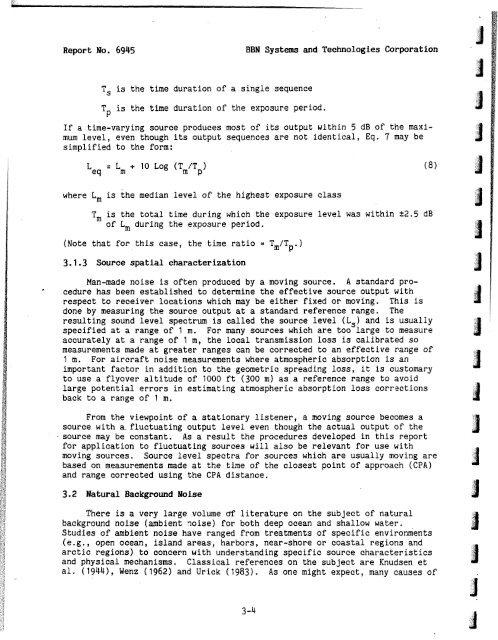Analysis and Ranking of the Acoustic Disturbance Potential of ...
Analysis and Ranking of the Acoustic Disturbance Potential of ...
Analysis and Ranking of the Acoustic Disturbance Potential of ...
You also want an ePaper? Increase the reach of your titles
YUMPU automatically turns print PDFs into web optimized ePapers that Google loves.
Report No. 6945<br />
BBN Systems <strong>and</strong> Technologies Corporation<br />
Ts is <strong>the</strong> time duration <strong>of</strong> a single sequence<br />
T is <strong>the</strong> time duration <strong>of</strong> <strong>the</strong> exposure period.<br />
P<br />
If a time-varying source produces most <strong>of</strong> its output within 5 dB <strong>of</strong> <strong>the</strong> maximum<br />
level, even though its output sequences are not identical, Eq. 7 may be<br />
simplified to <strong>the</strong> form:<br />
L = Lm + 10 Log (Tm/T )<br />
e q<br />
P<br />
where Lm is <strong>the</strong> median level <strong>of</strong> <strong>the</strong> highest exposure class<br />
Tm is <strong>the</strong> total time during which <strong>the</strong> exposure level was within k2.5 dB<br />
<strong>of</strong> Lm during <strong>the</strong> exposure period.<br />
(Note that for this case, <strong>the</strong> time ratio - T,/Tp.)<br />
3.1.3 Source spatial characterization<br />
Man-made noise is <strong>of</strong>ten produced by a moving source. A st<strong>and</strong>ard procedure<br />
has been established to determine <strong>the</strong> effective source output with<br />
respect to receiver locations which may be ei<strong>the</strong>r fixed or moving. This is<br />
done by measuring <strong>the</strong> source output at a st<strong>and</strong>ard reference range. The<br />
resulting sound level spectrum is called <strong>the</strong> source level (Ls) <strong>and</strong> is usually<br />
specified at a range <strong>of</strong> 1 m. For many sources which are too large to measure<br />
accurately at a range <strong>of</strong> 1 m, <strong>the</strong> local transmission loss is calibrated so<br />
measurements made at greater ranges can be corrected to an effective range <strong>of</strong><br />
1 m. For aircraft noise measurements where atmospheric absorption is an<br />
important factor in addition to <strong>the</strong> geometric spreading loss, it is customary<br />
to use a flyover altitude <strong>of</strong> 1000 ft (300 m) as a reference range to avoid<br />
large potential errors in estimating atmospheric absorption loss corractions<br />
back to a range <strong>of</strong> 1 m.<br />
From <strong>the</strong> viewpoint <strong>of</strong> a stationary listener, a moving source becomes a<br />
source with a,fluctuating output level even though <strong>the</strong> actual output <strong>of</strong> <strong>the</strong><br />
source may be constant. As a result <strong>the</strong> procedures developed in this report<br />
for application to fluctuating sources will also be relevant for use with<br />
moving sources. Source level spectra for sources which are usually moving are<br />
based on measurements made at <strong>the</strong> time <strong>of</strong> <strong>the</strong> closest point <strong>of</strong> approach (CPA)<br />
<strong>and</strong> range corrected using <strong>the</strong> CPA distance.<br />
3.2 Natural Background Noise<br />
There is a very large volume <strong>of</strong> literature on <strong>the</strong> subject <strong>of</strong> natural<br />
background noise (ambient ~oise) for both deep ocean <strong>and</strong> shallow water.<br />
Studies <strong>of</strong> ambient noise have ranged from treatments <strong>of</strong> specific environments<br />
(e.g., open ocean, isl<strong>and</strong> areas, harbors, near-shore or coastal regions <strong>and</strong><br />
arctic regions) to concern with underst<strong>and</strong>ing specific source characteristics<br />
<strong>and</strong> physical mechanisms. Classical references on <strong>the</strong> subject are Knudsen et<br />
a1 . ( 19441, Wenz ( 1962) <strong>and</strong> Ur ick ( 1983) . As one might expect, many causes <strong>of</strong>
















